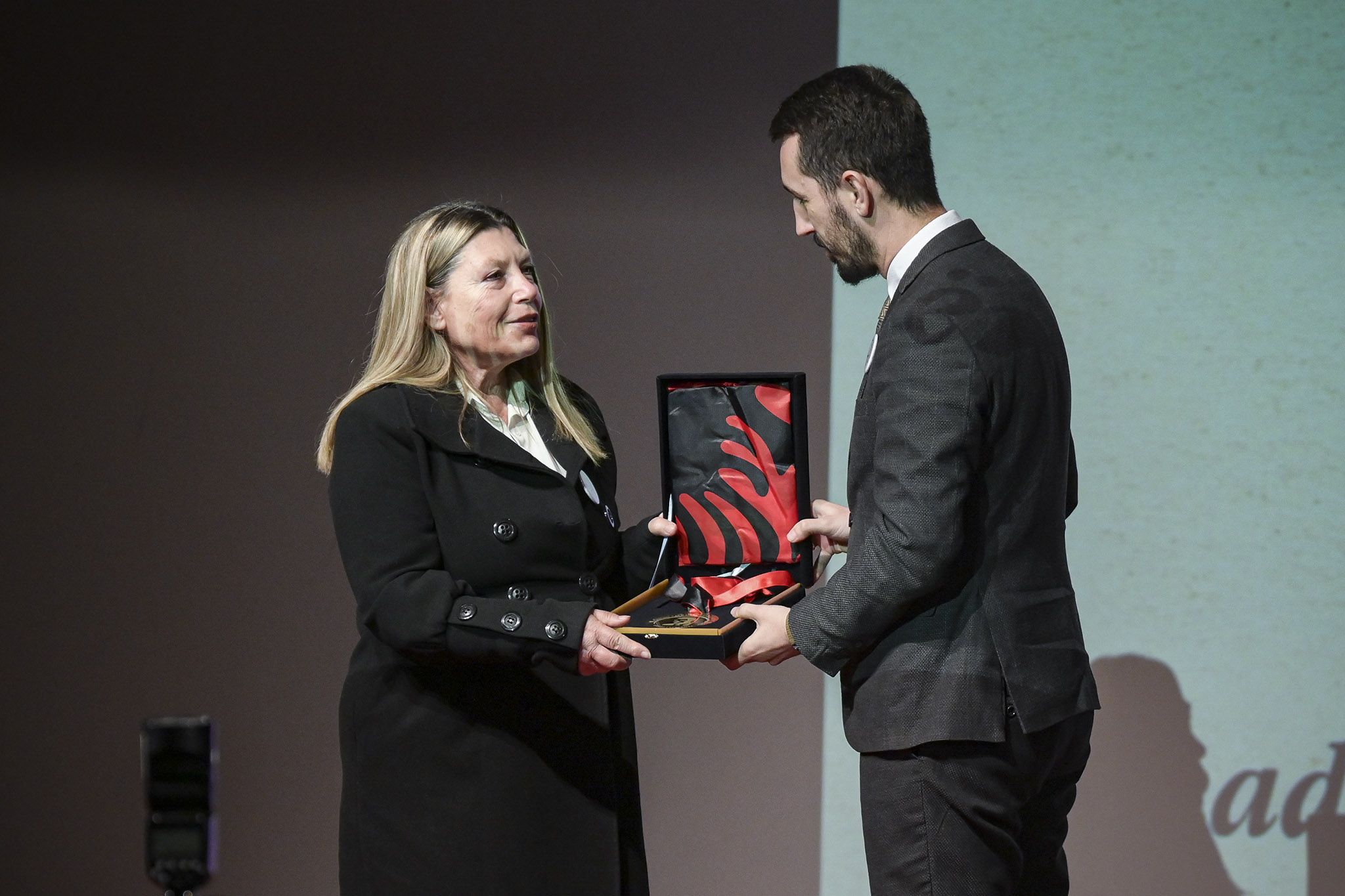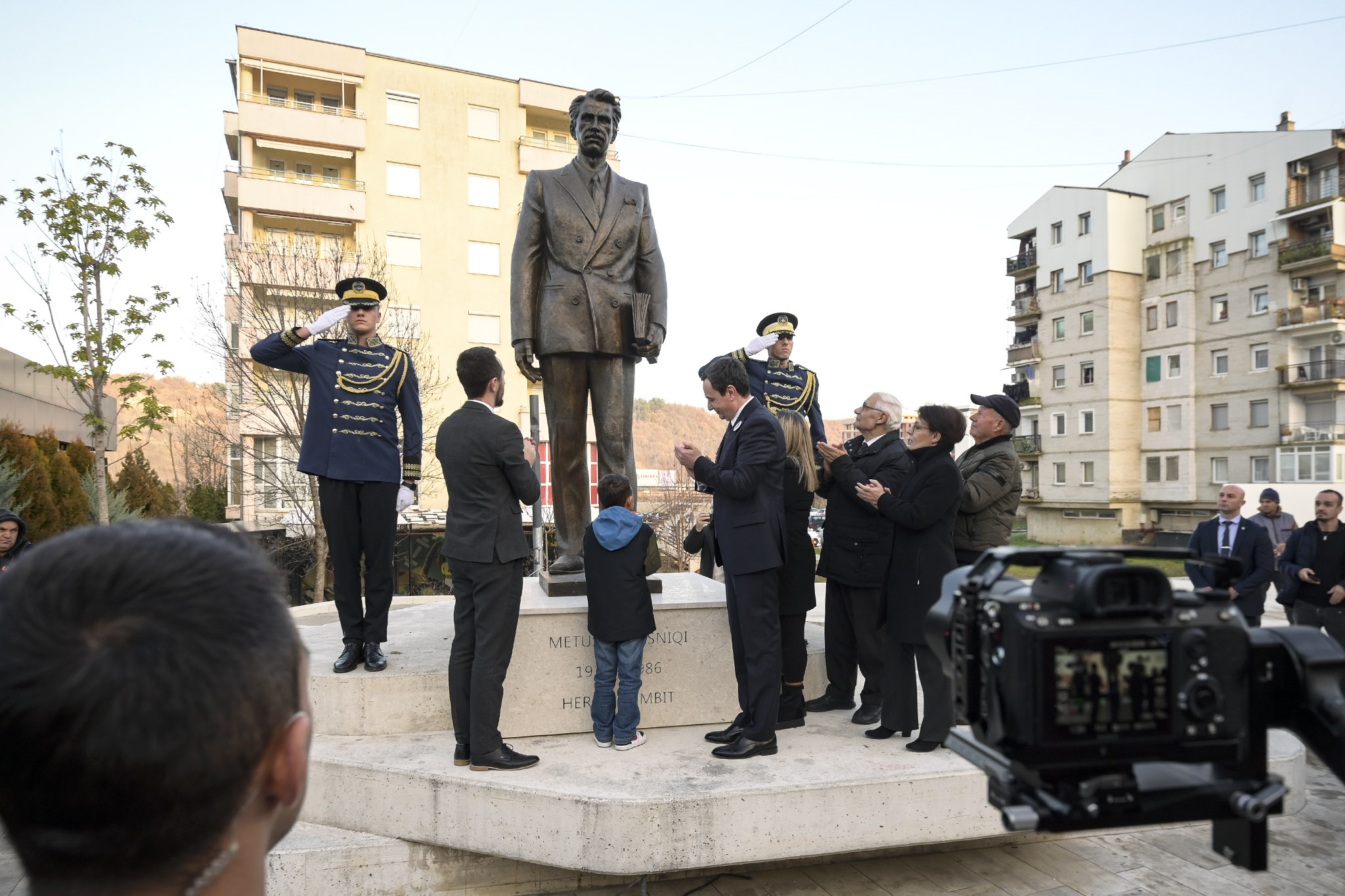Kamenica, 26 November 2024
Albin Kurti, the Prime Minister of the Republic of Kosovo, attended the commemorative event and the unveiling of the statue of activist Metush Krasniqi, marking the 38th anniversary of his passing, in the square named after him.
In honor of the life and work of Metush Krasniqi, the Prime Minister described him as one of the most relentless political activists for the national and political ideals of his time, who was only 20 years old when he was first imprisoned in 1947.
“By erecting this public artwork here in Kamenica, we not only honor the personality of Metush Krasniqi, but also solidify the historical figure he represents, giving a permanent place here in Kamenica to the political tradition Metush belonged to and the political legacy left among us by it and by himself,” said Prime Minister Kurti.
In his speech, the Prime Minister recalled the challenges of the judicial process that Metush Krasniqi endured, highlighting the discussions between him and the judge in court, emphasizing that these were not merely questions and answers between a defendant and a judge, but dialogues between two sides of history: the side of the oppressive Yugoslav regime, represented by the figure of the judge, and the side of the resistance of a people with a heightened awareness of freedom, embodied in the figure of Metush Krasniqi, the activist who bore the weight of his people’s oppression on his shoulders.
The ideals of Metush Krasniqi still resonate with us today, as they remind us of the arduous and bloody path we Albanians have traversed for the freedom of our country, the Prime Minister continued, adding that “the statue we are unveiling today should be seen as a monument to freedom. Because freedom is the prerequisite for all opportunities for development and progress, for well-being, and for self-determination”.
At this Commemorative Academy organized by the Municipality of Kamenica, the ‘Metush Krasniqi’ award was presented to the Krasniqi family by the Mayor of the Municipality, Kadri Rahimaj, and accepted by Metush’s daughter, Teuta Krasniqi.
Alongside the Prime Minister, the Deputy Prime Minister and Minister of Foreign Affairs and Diaspora, Donika Gervalla, was also present at the ceremony.
Prime Minister Kurti’s full speech:
Honorable Krasniqi family,
Honorable Mrs. Donika Gervalla, Deputy Prime Minister and Minister of Foreign Affairs and Diaspora,
Honorable Mr. Kadri Rahimaj, Mayor of the Municipality of Kamenica,
Honorable Mr. Shefik Sadiku, President of the Association of Political Prisoners of Kosovo,
Honorable members of the Assembly of the Republic,
Honored veterans and disabled fighters of the liberation war, families of martyrs and national activists,
Honorable ministers and deputy ministers, colleagues from the government and state institutions in general,
Distinguished attendees,
Ladies and gentleman,
Sisters and brothers,
Honored citizens of Kamenica, dear residents of Gollak and Anamorava, I have learned that many admirers of Metush Krasniqi have come here today, from the Presheva Valley to Struga; this last Tuesday of November has brought us all here to the town of Kamenica, in honor of Metush Krasniqi, one of the most unwavering political activists for the national and political ideals of his time. Metush Krasniqi was only 20 years old when he was imprisoned for the first time in 1947. He was 59 years old when he passed away, 38 years ago, in 1986. This year, when he could have turned 97 years old, an age possibly within the bounds of the living, he returns today to Kamenica to be immortalized in the public memory of the city through this statue.
By erecting this public artwork here in Kamenica, we not only honor the personality of Metush Krasniqi, but also solidify the historical figure he represents, giving a permanent place here in Kamenica to the political tradition Metush belonged to and the political legacy left among us by it and by himself.
By raising this piece of public art here in Kamenica, we not only honor the personality of Metush Krasniqi but also solidify the historical figure he represents, permanently embedding in Kamenica the political tradition to which Metush belonged and the political legacy he left among us through it and through himself. Therefore, on occasions like this, when certain dates or events bring us together in remembrance of the life lived and the life sacrificed by Metush Krasniqi, it is entirely natural to recall him as he was, through his own words.
The file of the judicial process against Metush Krasniqi, conducted in sessions between 01 March and 07 March 1959, in the District Court of Gjilan, can well be read as a political manifesto, filled with declarations, denunciations, and pure political proclamations about the oppression of Albanians and their plight under Yugoslavia. The discussions between Metush and the judge in the courtroom are not merely questions and answers between a defendant and a judge; however, they are dialogues between two sides of history: the side of the oppressive Yugoslav regime, represented by the figure of the judge, and the side of the resistance of a people with a high consciousness for freedom, personified by the figure of Metush Krasniqi, the activist who bears the burden of the oppression of his people on his shoulders.
Thus, two political forces as historical entities confronted each other: the oppressive and exploitative state of Yugoslavia and the freedom-loving Albanian people of Kosovo. In this entire clash, the political will of Albanians in Yugoslavia was clearly articulated from the defendant’s bench, where Metush Krasniqi, accused on political grounds, declared, and I quote:
“Firstly, Kosovo is brutally exploited by the Yugoslav regime, and the Albanian people are treated as if still under the Kingdom of Yugoslavia, denied even the most basic rights in all aspects of life, such as employment, administration, healthcare, education, culture, and more. Secondly, the ‘popular’ government of Tito’s Yugoslavia has not relieved the Albanian people of violence. I raise the question: how many Albanians have been executed without trial from November 1944 until today? How many murders have occurred in the name of the ‘enemies’ of the state? Tens of thousands of Albanians… perhaps even more than 20,000 across all Albanian territories in Yugoslavia. Thirdly, the disarmament campaign was carried out only in Kosovo to disarm the Albanians. Why was the same campaign not conducted in other republics? Why this violence and these violent deaths of Albanians? Why has a single rifle been sold dozens of times? Why were Albanians subjected to such terror in the name of the Communist Party of Yugoslavia?” In our region, in Kamenica, this resulted in three deaths and over 3,000 people being physically mistreated with the most sadistic methods, which only anti-popular regimes can inflict upon their citizens, treating them as slaves!”
This statement, divided into three points, is where Metush Krasniqi denounces the rule, terror, and violence of the Yugoslav state and the ethnic discrimination against Albanians. All of this was happening in the early year of 1959, and as much as it was true for the past, it would remain true for decades to come, until the liberation of Kosovo 40 years later. So, the ideals of Metush Krasniqi still speak to us today, every day, because they remind us of the arduous and bloody path we Albanians have taken for the freedom of our country. Therefore, the statue we are inaugurating today should be seen as a monument to freedom. Because freedom is the prerequisite for all opportunities for development and progress, for self-determination and well-being.
Glory to Metush Krasniqi and all those who sacrificed their lives, committing themselves so completely as Metush did for the freedom of our homeland!
Thank you.
Last modified: December 2, 2024


























